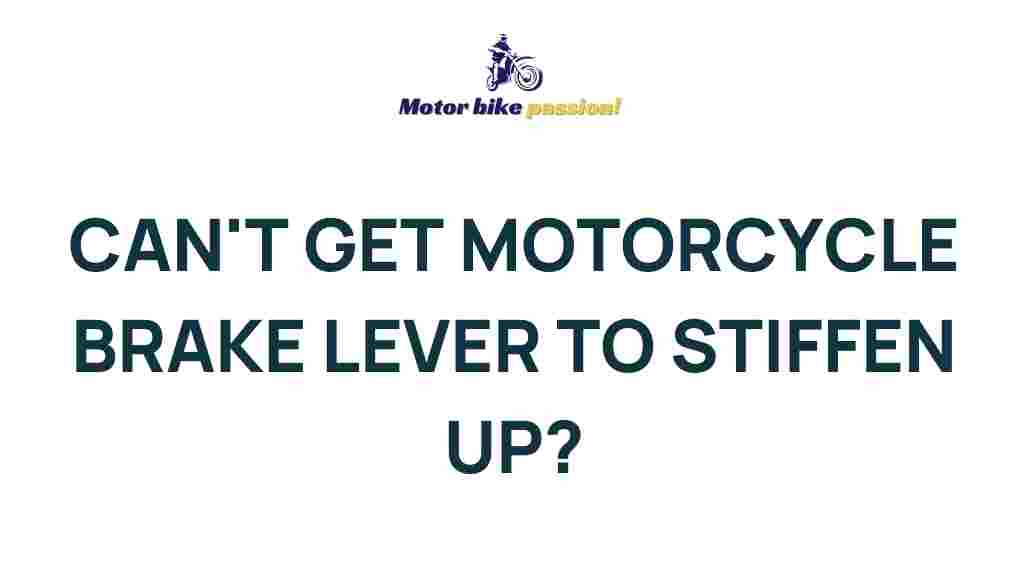Unveiling the Mystery: How to Make Your Motorcycle Brake Lever Stiffer
Motorcycle enthusiasts understand the importance of control and safety while riding. One crucial component that significantly affects both is the motorcycle brake lever. If you find that your brake lever feels too soft or lacks the necessary stiffness, it can impact your ability to stop effectively. In this article, we will uncover the mystery behind adjusting the stiffness of your motorcycle brake lever, ensuring better control and enhancing your overall riding experience.
Understanding Brake Lever Stiffness
The stiffness of your motorcycle’s brake lever plays a vital role in how responsive your brakes are. A stiffer brake lever usually means:
- Improved control: Stiffer levers allow for more precise modulation of brake pressure.
- Enhanced safety: A firm brake lever can lead to faster stopping times and better response in emergencies.
- Reduced fatigue: Proper lever adjustment can make long rides more comfortable by reducing the effort needed to brake.
Understanding how to adjust your brake lever’s stiffness can make a significant difference in your riding experience. In the following sections, we will discuss the necessary steps for adjusting your motorcycle brake lever.
Tools Needed for Adjustment
Before diving into the adjustment process, it’s essential to gather the right tools:
- Socket wrench set
- Torque wrench
- Adjustable pliers
- Brake fluid (if needed)
- Clean rags or cloths
- Safety goggles and gloves
Step-by-Step Process for Adjusting Brake Lever Stiffness
1. Assess Your Current Brake Lever Setup
Start by examining your motorcycle brake lever’s current setup. Pay attention to the following:
- Lever position: Is it too close or too far from the handlebar?
- Lever free play: How much movement does the lever have before it engages the brakes?
- Brake fluid level: Check if the brake fluid is at the recommended level in the reservoir.
2. Adjust the Lever Position
A common way to increase the stiffness of your brake lever is to adjust its position. Here’s how:
- Locate the adjustment screw on the brake lever assembly.
- Turn the screw clockwise to move the lever closer to the handlebar, which may increase stiffness.
- Test the lever feel after adjustment. It should feel more responsive with less free play.
3. Check for Brake Line Issues
Sometimes, the brake line can affect the lever’s stiffness. Follow these steps:
- Inspect the brake line for any signs of wear or damage.
- Ensure the brake line is not kinked or bent, as this can cause a spongy feel.
- If you notice any issues, consider replacing the brake line to improve stiffness.
4. Adjust the Brake Fluid Levels
Low brake fluid levels can lead to a soft lever feel. To adjust the fluid level:
- Remove the brake fluid reservoir cap carefully.
- Add brake fluid to the recommended level, ensuring you use the correct type for your motorcycle.
- Replace the reservoir cap and test the lever for improved stiffness.
5. Bleed the Brake System
If your brake lever still feels soft, it may be time to bleed the brake system. This process removes air bubbles that can cause a spongy feel:
- Locate the bleeder valve on the brake caliper.
- Attach a clear tube from the bleeder valve to a catch container.
- Open the valve and squeeze the brake lever several times until you see fluid without air bubbles.
- Close the valve and check the lever feel again.
6. Inspect the Brake Pads
Worn brake pads can also affect lever stiffness. Check the pads by:
- Removing the wheel to access the brake caliper.
- Inspecting the thickness of the brake pads.
- Replacing worn pads to restore proper braking performance.
7. Test Your Adjustments
Once you have made the necessary adjustments, it’s time to test them:
- Start your motorcycle and squeeze the brake lever to feel for any changes in stiffness.
- Take your motorcycle for a short ride, testing the brakes at various speeds.
- Ensure the lever feels firm and responsive without any unusual sounds or feelings.
Troubleshooting Common Brake Lever Issues
Even after adjustments, you may encounter issues with your motorcycle brake lever. Here are some common problems and solutions:
Soft Brake Lever
If your brake lever still feels soft after adjustments:
- Check for air in the brake lines and bleed the system again if necessary.
- Inspect the condition of the brake fluid; it should be clear and free of contaminants.
- Ensure that the brake pads are not excessively worn.
Brake Lever Sticking
If the brake lever is sticking or feels jammed:
- Examine the lever pivot point for dirt or debris and clean it thoroughly.
- Apply lubricant to the pivot point to ensure smooth operation.
- Check the brake cable or line for any obstructions.
Uneven Brake Performance
If you experience uneven braking:
- Inspect both brake pads and ensure they are wearing evenly.
- Check the caliper alignment to ensure it is centered over the rotor.
- If one side is wearing more than the other, consider adjusting the caliper or replacing the pads.
Conclusion
Adjusting the stiffness of your motorcycle brake lever is not only essential for improved control and safety but also enhances your overall riding experience. By following the steps outlined in this article, you can ensure that your brake lever functions optimally, providing you with the confidence and safety you need on the road.
Remember, regular maintenance and adjustments can prolong the life of your motorcycle’s braking system. If you ever feel unsure about your adjustments or encounter persistent issues, don’t hesitate to consult a professional mechanic.
For more tips on motorcycle maintenance and safety practices, visit this comprehensive guide. Additionally, learn more about motorcycle parts and upgrades at Motorcycle.com.
This article is in the category Maintenance Tips and created by MotorBikePassion Team
